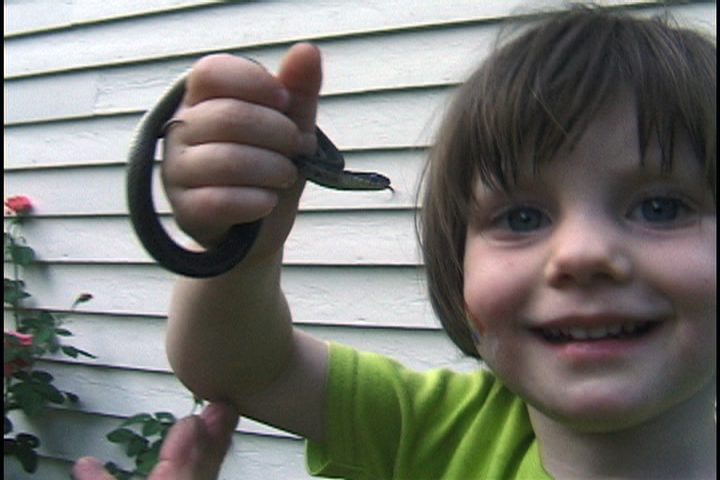
Contributed by Jonathan Stevenson / During and after the AIDS epidemic, gay artists like Carlos Alfonzo, Ross Bleckner, Robert Gober, and Keith Haring used visual art to convey the tragedy of mass premature death that gutted the art world, as well as the political injustice of the U.S. government�s refusal to recognize the gravity of the disease. It was a way to help an entire community to come to grips with heartbreaking loss that seemed especially undeserved and unfair. In her satisfyingly unconventional new documentary, Instructions on Parting, video artist Amy Jenkins confronts such jarring loss at the level of family, in the process memorializing several close relatives and arriving at a kind of coping strategy. Within a few years of her daughter�s birth, Jenkins� sister Linda, mother Ellen, and brother Craig had died from disease, all of them much sooner than they�d have reasonably hoped or expected.

The title of Jenkins� quietly intense and affecting film chronicle of this family ordeal has a tinge of sardonicism. The proposition that a person can truly prepare for the gut-wrenching death of a loved one is intuitively hard to swallow. Yet by the end of the film, which screened on February 16 at the Museum of Modern Art in its Doc Fortnight 2018 Film Festival, she has made an eloquent case that experience and contemplation can at least soften the unavoidable existential dilemma. Jenkins employs a number of ostensibly earnest, even hackneyed, ideas in archly clever ways. Perhaps the most prominent is the family slideshow � an iconic source of collective boredom, proverbially foisted on children by cloyingly wistful parents. She subverts that status, recasting the slideshow as a painful but constructive means of taking stock of life and reckoning with mortality. The family is initially crushed, but over time the regimen of acclimation takes hold. When Linda makes it to 43, they can joke about Ellen�s mistakenly putting her age at death as 42 in a draft obituary. The moment might have seemed forced or at least leadenly prosaic, but the film illuminates it as the sensible and natural domestication of death.

Linda�s passing inures the family to a slow demise, and Ellen herself develops breast cancer that metastasizes to her lungs. But, after undergoing a procedure to have them drained, Ellen dies suddenly in her sleep. Writing in her diary, Jenkins muses that �Mom�s death feels like a renunciation� of agonizing goodbyes. There�s no such reprieve from Craig�s protracted decline from a rare sarcoma, which the family comes to know will inevitably kill him. But they�ve learned. Jenkins, her father, and Craig himself don�t tiptoe around the elephant in the room, as they had for a time with Linda. She applies herself purposefully to the task of easing her brother�s burden of anticipation in light of his brave, paradoxically life-affirming determination �to watch the whole thing fall away� as time cruelly slows down. When Jenkins records that Craig has written on his wall calendar for September 23, 2006, simply �die?,� she conveys not so much tragedy as the courage to confront, up close, an inexorable fate.

The structure of the film is light but sturdy, facilitating a vivid visual translation of psychological truth. Almost from the beginning, the prospect of death is telegraphed by the onset of disease and provides plenty of narrative tension. Filming with a handheld camera but still discreetly, Jenkins intersperses the two family watches, effectively conveyed through recorded telephone messages and diary entries as well as direct testimony, with intimate scenes of humans (mainly, her growing baby) and nature vignettes (tree removal, birds in a nest, seasons passing). The juxtaposition of death and life can be a clich�, too, of course. But Jenkins launches the imagery knowingly, as acknowledgement that clich�s, however rooted in shared experience, are never quite enough to accommodate a particular person�s life. In turn, it would be jejune to suggest that Jenkins herself has embraced death; but she no longer fears having it in the living room.
�Instructions on Parting,� directed, produced, edited by Amy Jenkins. On view at Doc Fortnight 2018: MoMA�s
International Festival of Nonfiction Film and Media. Museum of Modern Art, New York, NY. World Premiere, February 16, 2018.
Other credits:
Producer Mary Kerr
Editor Bara Jichova-Tyson
Consulting Editor Laure Sullivan
Composer Noah Hoffeld
Sound Designer Jim Dawson
Related posts:
ON FILM: Blonde on blondes
Art and film: Bruce Conner, escape artist
Cathy Nan Quinlan�s collection
Ideas and Influences: Stephen Truax
A better bonfire at the Whitney: Painting from the 1980s
















